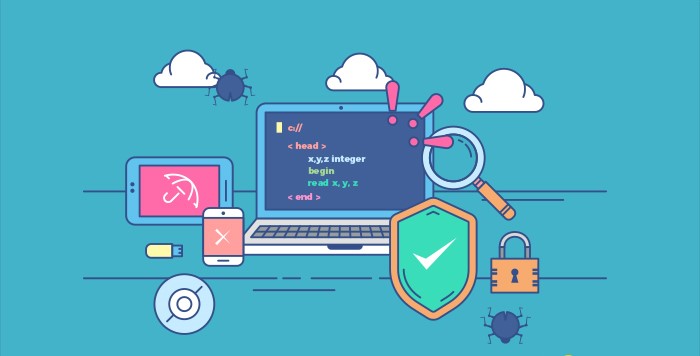What is Software Testing?
Software testing is one of the techniques and methods used to check the outcome of the developed software. Software testing phase is the second or third last phase if you follow a software development life cycle (SDLC). Testing is done to ensure whether the software is performing the task as it was required. There are many different types of testing software available. Besides the output of the software, other necessary things are also checked and tested. Other testing includes the coding techniques, methods, line of codes, or how much stress can the software handle? How many loads can be handled? These are the main points which are checked and tested to decide whether the software is able to handle all of these.
Software testing is highly essential before delivering the end product to the consumer. In software development, first the requirement specifications are gathered and a feasibility study is conducted to check whether all the functionalities mentioned can be included in the software or not. Its possibilities are studied. After it is done, software design is made both – the physically and logically. Then comes the coding phase in which the design is converted into codes. The coding phase is also called implementation. After the coding comes to the testing phase where a software undergoes numerous amounts of tests. When the testing phase is cleared, maintenance schemes are made. The maintenance phase is the step which requires a huge amount of effort. Now that we are aware of how the software process goes through, let us study different types of software testing.
Types of Software Testing
There are various types of testing techniques available to test software.
The different tests are as follows:
- Alpha Testing – Alpha testing is a type of testing which is conducted at the developer’s site. For this type of testing the customer/ client or user has to go to the developer where the testing is being done. It is done to clear an internal acceptance before the software goes for the next type of testing. If there are errors, the customer can directly talk to the developer and if any variation is required, then it can be discussed.
- Beta Testing – Beta testing is conducted after alpha testing. It is conducted to clear external user acceptance testing. You might have heard the term beta versions; In this, the programmer sends the beta version of software to a group of people or audience (outside the programming team) that use the software. Based on their usage and experience they give feedback to the programmer. If there is an error in an area or in some areas, then these errors are cleared and work is done accordingly. Sometimes, the public is invited to download such versions and give feedback about it. This is done to get as many feedbacks as possible. Also, the public becomes happy that they are able to contribute to the betterment of the software.
- Unit Testing – As the name specifies, unit testing is conducted to check a particular unit of the software. A single module is tested and certain steps are taken depending on the results. It is done to ensure and validate that every module is working as per its requirements. Smallest testable part of the software is called a unit. In this type of testing stubs and drivers are used. They are used because this unit might take input from another unit but since it is unit testing other modules are not tested along. To overcome this problem stubs and drivers are used.
- Integration – Integration testing is just the opposite of unit testing. As in unit testing, one module is tested at a time whereas in integration testing, more than one module is tested usually two modules are integrated and then tested. Example, there are two modules – module A and module B, these modules will be combined first and then they will be tested. It is performed after the unit testing. All the modules that are unit tested are grouped together. After grouping them, integration testing is conducted. It is done to ensure that the modules are performing properly together as in the software modules have to work in coordination and combination to provide the desired output.
- Black Box Testing – Black box testing is conducted only to check whether it is delivering the required output or not. In this testing, only output is checked and not the coding. Due to this reason, it is called black-box testing as all the coding ethics, logic, etc. are ignored and only the outcome is seen. Being a software tester is a great opportunity for students as strong coding knowledge is not required. For better understanding, this testing, let’s take an example, suppose you are making a calculator that must give accurate results. It doesn’t matter, whether you use any loop or counter or any decision-making statement, what matters is that the result must be accurate.
- White Box Testing – White box testing is the reverse of black-box testing. In this testing, the coding and programming ethics, line of codes, logics of different modules, etc. are tested. Hence, it is known as white box testing. A white box software tester must have strong coding knowledge and programming skills to design the test cases and test the module. Other names for black-box testing are clear box testing, glass box testing, transparent box testing, and structural testing. Internal structures of software are tested. For instance, suppose you made a software named write my essay for me and it helps a student in writing his or her essay, even if this software generates accurate result but the logic is not correct that it will be checked and rectified.
- Regression Testing – Regression in software engineering means that the software is still functioning properly. Sometimes it happens that while adding new features to the software the old feature might stop working. To solve such problem regression testing is conducted to ensure that all the existing features work fine with the newly added features. The old test cases are used to test the software again. This testing is conducted even while the new updates are given to ensure that old functionality is still performing accurately.
- Functional Testing – Functional testing tests the functions in the software. All the functions that the software was expected to perform are tested. In this testing, a comparison is made between the actual software and the expected software. The functionalities are checked and if there is an error and the software is not able to perform a particular function, then it needs to be reprogrammed. Once the error is resolved it is again tested so that it clear the functional testing.
- Acceptance Testing – In this testing, the system is checked by the actual user with the live data. All the requirements mentioned in the SRS (Software Requirement Specifications) document or the contract are tested and if they are working fine that means the software has cleared the acceptance testing. It is also called user acceptance testing where it is checked by the user and the confirmation of the client is obtained that all their requirements and the functionalities are met.
- Program Testing – In program testing, errors in the programs are tested and checked. It is done to ensure that the program is error-free and to test whether the programs are delivering the desired output or not. In program testing, two types of errors are checked. They are Syntax testing and Logic testing. In syntax testing, coding ethics and language rules are checked. Even in programming, there are certain language rules that are needed to be followed. Not following these rules will generate an error, if this error occurs it is corrected and in this way, coding ethics are followed. In logic testing, the logic of the programs is tested and corrected if an error occurs. Logic errors are incorrect data types, out of range items, etc. if such an error occurs, then they are rectified and cleared. In this way, program testing is done.
- Stress Testing – Stress testing is testing a system beyond its normal limits. It is tested to check the stability of the software. Robustness of software is checked. It is checked how much stress can a software handle. It is tested outside its normal operational capacity and a breaking point of the software is found. It the software breaks before the actual stage, then steps are taken to check the issue due to which happened and they are resolved. After resolving, it is again checked to ensure whether it is working according to the required capacity. Robustness and availability are given greater emphasis.
These are the eleven types of testing which software has to undergo. Testing is a very vast concept, it is not limited to these eleven types of testing. Apart from these testing, there are other types of testing like string testing, system testing, series testing, etc.


